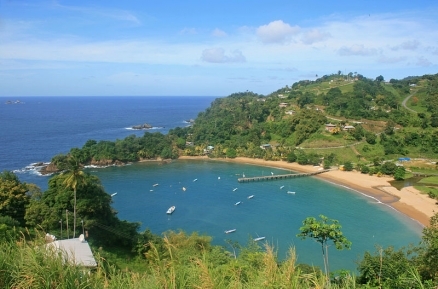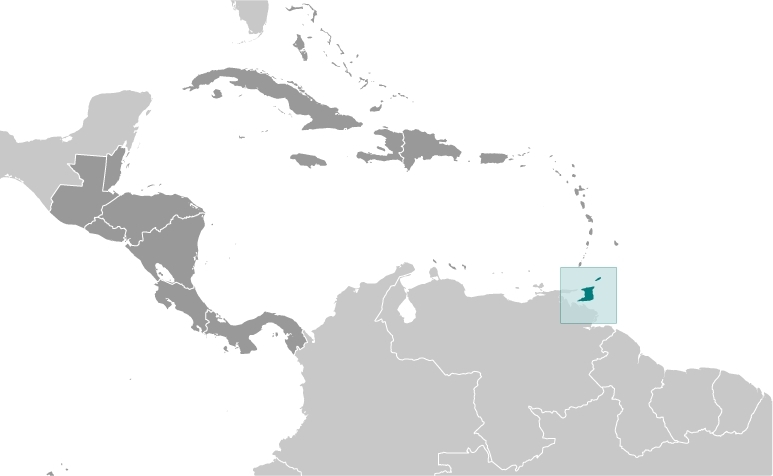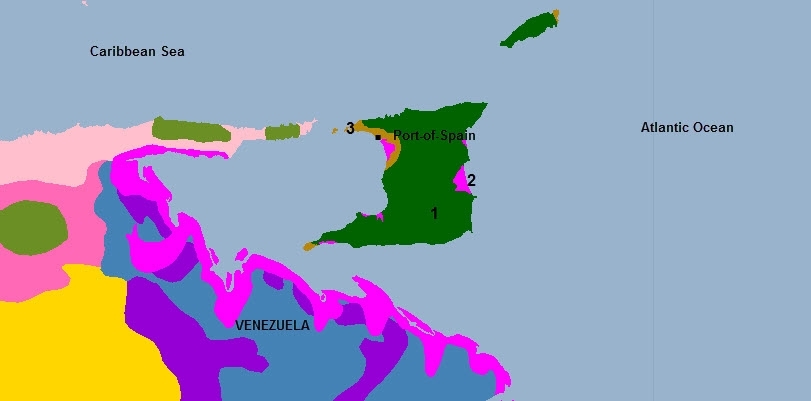Trinidad and Tobago
Countries and Regions of the World Collection  The Republic of Trinidad and Tobago is an archipelagic nation of one-and-a-quarter million people in the southern Caribbean, lying northeast of the South Americancountry of Venezuela and south of Grenada in the Lesser Antilles.
The Republic of Trinidad and Tobago is an archipelagic nation of one-and-a-quarter million people in the southern Caribbean, lying northeast of the South Americancountry of Venezuela and south of Grenada in the Lesser Antilles.
It shares maritime boundaries with other nations including: Barbados to the northeast, Guyana to the southeast, and Venezuela to the south and west.
The country covers an area of 5,128square kilometres (1,980sqmi) and consists of two main islands, Trinidad and Tobago, and numerous smaller landforms.
Trinidad is the larger and more populous of the main islands; Tobago is much smaller, comprising about 6% of the total area and 4% of the population. The nation lies outside the hurricane belt.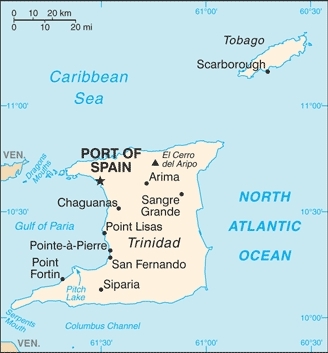
First colonized by the Spanish, the islands came under British control in the early 19th century.
The islands' sugar industry was hurt by the emancipation of the slaves in 1834. Manpower was replaced with the importation of contract laborers from India between 1845 and 1917, which boosted sugar production as well as the cocoa industry.
The discovery of oil on Trinidad in 1910 added another important export.
Independence was attained in 1962. The country is one of the most prosperous in the Caribbean thanks largely to petroleum and natural gas production and processing.
Tourism, mostly in Tobago, is targeted for expansion and is growing. The government is coping with a rise in violent crime.
Its major environmental issues include water pollution from agricultural chemicals, industrial wastes, and raw sewage; oil pollution of beaches; deforestation; and soil erosion.
Contents
Geography
Location: Caribbean, islands between the Caribbean Sea and the North Atlantic Ocean, northeast of Venezuela
Geographic Coordinates:11 00 N, 61 00 W
Area: 5,128 sq km (all land)
Coastline:362 km
Maritime Claims (as measured from claimed archipelagic baselines) Territorial sea to 12 nautical miles; contiguous zone to 24 nautical miles; exclusive economic zone to 200 nautical miles; continental shelf to 200 nautical miles or to the outer edge of the continental margin.
Natural Hazards: Outside usual path of [[hurricane]s and other tropical storms].
Terrain: Mostly plains with some hills and low mountains. Thehighest point isEl Cerro del Aripo (940 m).
Climate: Tropical; rainy season (June to December).
Capital: Port-of-Spain
Ecology and Biodiversity
Due to recent separation from South America these island's flora andfauna reflect the ecology of equatorial South America more than any other Windward Island where biotic endemism is common.
1. The Trinidad and Tobago moist forests differ greatly from the moist forests of the Windward islands to the north and comprise approximately 90% of the land area of the archipelagic state of Trinidad and Tobago. Both islands lie on the South American Continental Shelf and are directly influenced by the Orinoco and the South Equatorial Current.
2. Mangroves are extensively developed in the Trinidad mangroves ecoregion because of a salinity gradient associated with the outflows of the Amazon and Orinoco rivers, which, on a global scale, are responsible for 20% of total freshwater inputs to the ocean. They are also found in diverse conditions in association with a variety of other habitats.
3. The Trinidad and Tobago dry forests ecoregion covers only a small portion of land area in the northwest of Trinidad and the very northern end of Tobago.
Protected Areas
Approximately 5% (24,748 {C}hectares) of the land area in Trinidad and Tobago is protected through legislation and as much as 13% (69,000 ha) has been proposed. While these further protected areas have yet to be approved by the government, the proposals may serve to indicate the future direction of environmental protection in Trinidad and Tobago.
People and Society
Population: 1,226,383 (July 2012 est.)
Age Structure:
0-14 years: 19.5% (male 122,044/female 116,859)
15-64 years: 72.1% (male 455,148/female 429,990)
65 years and over: 8.4% (male 44,439/female 59,025) (2011 est.)
Population Growth Rate: -0.086% (2012 est.)
Birthrate: 14.25 births/1,000 population (2012 est.)
Death Rate: 8.35 deaths/1,000 population (July 2012 est.)
Net Migration Rate: -6.76 migrant(s)/1,000 population (2012 est.)
Life Expectancy at Birth: 71.67 years
male: 68.81 years
female: 74.6 years (2012 est.)
Total Fertility Rate: 1.72 children born/woman (2012 est.)
Languages:English (official), Caribbean Hindustani (a dialect of Hindi), French, Spanish, Chinese
Literacy: 98.6% (2003 est.)
Urbanization: 14% of total population (2010) growing at a 3% annual rate of change (2010-15 est.)
History
Columbus landed on and named Trinidad in 1498, and Spaniards settled the island a century later. Spanish colonizers largely wiped out the original inhabitants--Arawak and Carib Indians--and the survivors were gradually assimilated. Although it attracted French, free black, and other non-Spanish settlers, Trinidad remained under Spanish rule until the British captured it in 1797. During the colonial period, Trinidad's economy relied on large sugar and cocoa plantations. Tobago's development was similar to other plantation islands in the Lesser Antilles and quite different from Trinidad. During the colonial period, French, Dutch, and British forces fought over possession of Tobago, and the island changed hands 22 times--more often than any other West Indies island. Britain took final possession of Tobago in 1803. The two islands of Trinidad and Tobago were incorporated into a single colony in 1888. Trinidad and Tobago achieved full independence in 1962 and joined the British Commonwealth. Trinidad and Tobago became a republic in 1976.
The people of Trinidad and Tobago are mainly of African or East Indian descent. Virtually all speak English. Small percentages also speak Hindi, French patois, and several other dialects. Trinidad has two major folk traditions: Creole and East Indian. Creole is a mixture of African elements with Spanish, French, and English colonial culture. Trinidad's East Indian culture came to the island beginning May 30, 1845 with the arrival of indentured servants brought to fill a labor shortage created by the emancipation of the African slaves in 1838. Most remained on the land, and they still dominate the agricultural sector, but many have become prominent in business and the professions. East Indians have retained much of their own way of life, including Hindu and Muslim religious festivals and practices.
The first political party in Trinidad and Tobago with a continuing organization and program--the People's National Movement (PNM)--emerged in 1956 under Dr. Eric Williams, who became Prime Minister upon independence and remained in that position until his death in 1981. Politics have generally run along ethnic lines, with Afro-Trinidadians supporting the PNM and Indo-Trinidadians supporting various Indian-majority parties, such as the United National Congress (UNC). Most political parties, however, have sought to broaden their appeal, and their candidate lists for the November 2007 and May 2010 parliamentary elections reflected this.
The PNM remained in power following the death of Dr. Williams, but its 30-year rule ended in 1986 when the National Alliance for Reconstruction (NAR), a "rainbow party" aimed at Trinidadians of both African and Indian descent, won a landslide victory by capturing 33 of 36 seats. Tobago's A.N.R. Robinson, the NAR political leader, became Prime Minister. The NAR began to break down when the Indian component withdrew in 1988. Basdeo Panday, leader of the old United Labor Front (ULF), formed the new opposition with the UNC.
In July 1990, the Jamaat al Muslimeen, an extremist Black Muslim group with an unresolved grievance against the government over land claims, tried to overthrow the NAR government. The group held the prime minister and members of parliament hostage for 5 days while rioting and looting shook Port of Spain. After a long standoff with the police and military, Jamaat leader Yasin Abu Bakr and his followers surrendered to Trinidad and Tobago authorities. In 1992, the Court of Appeal upheld the validity of a government amnesty given to the Jamaat members during the hostage crisis. Abu Bakr and 113 other Jamaat members were jailed for 2 years while other courts debated the amnesty's validity. All 114 members were eventually released after a ruling by the U.K. Privy Council.
In 1991 elections, the NAR lost control of the government to the PNM, led by Patrick Manning who became prime minister. The Panday-led UNC finished second and replaced the NAR as chief opposition party. In 1995 Manning called for elections, in which the PNM and UNC both won 17 seats and the NAR won two seats. The UNC allied with the NAR and formed the new government, with Panday becoming prime minister--the first prime minister of East Indian descent. Although elections held in 2000 returned the UNC to power, the UNC government fell in 2001 with the defection of three of its parliamentarians, and the subsequent elections resulted in an even 18-18 split between the UNC and the PNM. President A.N.R. Robinson bypassed his former party colleague Panday by inviting PNM leader Manning to form a government, but the inability to break the tie delayed Parliament from meeting. Manning called elections in 2002, after which the PNM formed the next government with a 20-16 majority.
Elections were held again on November 5, 2007, with the PNM winning 26 seats and the UNC securing the remaining 15; the Congress of the People party (COP) won no seats. Following the vote, Prime Minister Patrick Manning took his oath of office on November 7 to begin another term. In April 2010, however, the Prime Minister determined to dissolve Parliament early and elections were called for May 24. That vote pitted the PNM against a coalition known as the People’s Partnership (PP) made up of the UNC and COP as well as some smaller parties, including the Tobago Organization of the People (TOP) and the Movement for Social Justice. The partnership emerged victorious with 29 seats against the PNM’s 12 seats and Kamla Persad-Bissessar replaced Manning as Prime Minister, becoming the first woman in the nation’s history to hold that office. All three major parties are committed to free market economic policies and increased foreign investment. Trinidad and Tobago cooperates with the United States in the regional fight against narcotics trafficking and on other issues. This positive and fruitful relationship has continued and grown stronger under the PP government. On August 21, 2011, following a weekend of violence including eleven murders, the government declared a state of emergency (SOE) which was extended by Parliament, expiring on December 5, 2011. The curfew accompanying the SOE was controversial and was eventually reduced. On November 24, 2011, the Prime Minister announced the government uncovered an assassination plot against her and several members of her cabinet. Ultimately, seventeen men were arrested under SOE rules, but all were released without charge on December 5 with the expiration of the SOE.
Government
Government Type: parliamentary democracy
Trinidad and Tobago is a unitary state, with a parliamentary democracy modeled after that of Great Britain. Although completely independent, Trinidad and Tobago acknowledged the British monarch as the figurehead chief of state from 1962 until 1976. In 1976 the country adopted a republican Constitution, replacing Queen Elizabeth with a president elected by Parliament. The general direction and control of the government rests with the cabinet, led by a prime minister and answerable to the bicameral Parliament.
The members of the House of Representatives are elected to terms of at least 5 years. Elections may be called earlier by the president at the request of the prime minister or after a vote of no confidence in the House of Representatives. Parliamentary elections took place on November 5, 2007; the number of seats contested in the House of Representatives in that vote increased from 36 to 41. The same number of seats were contested in the May 24, 2010 elections. The Senate's 31 members are appointed by the president: 16 on the advice of the prime minister, 6 on the advice of the leader of the opposition, and 9 independents selected by the president from among outstanding members of the community. Elected councils administer the nine regional, two city, and three borough corporations on Trinidad. Since 1980 the Tobago House of Assembly has governed Tobago with limited responsibility for local matters.
Capital: Port-of-Spain - 57,000 (2009)
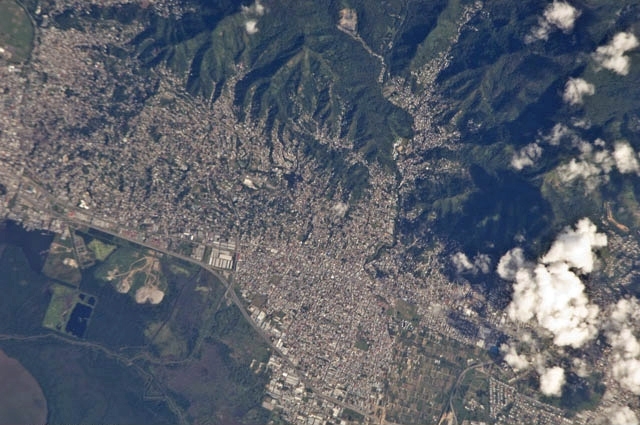
Port-of-Spain, 2010. Source: NASA.

Port-of-Spain panorama, 2008. Source:Christian Welsh/Wikimedia Commons.
Administrative divisions: 9 regions, 3 boroughs, 2 cities, 1 ward
regions: Couva/Tabaquite/Talparo, Diego Martin, Mayaro/Rio Claro, Penal/Debe, Princes Town, Sangre Grande, San Juan/Laventille, Siparia, Tunapuna/Piarco
borough: Arima, Chaguanas, Point Fortin
cities: Port of Spain, San Fernando
ward: Tobago
Independence Date: 31 August 1962 (from the UK)
Legal System: English common law; judicial review of legislative acts in the Supreme Court. Trinadad and Tobago has not submitted an International Court of Justice (ICJ) jurisdiction declaration; but accepts International criminal court (ICCt) jurisdiction.
The country's highest court is the Court of Appeal, whose chief justice is appointed by the president after consultation with the prime minister and leader of the opposition. The Judicial Committee of the Privy Council in London decides final appeal on some matters. Member states of the Caribbean Community (CARICOM) selected Trinidad as the headquarters site for the new Caribbean Court of Justice (CCJ), which is intended eventually to replace the Privy Council for all CARICOM states. The CCJ heard its first case in August 2005. Despite having its seat in Port of Spain, the CCJ has not yet supplanted the Privy Council for Trinidad and Tobago due to a legislative dispute over constitutional reform.
International Environmental Agreements
Trinidad and Tobago is party to international agreements on: Biodiversity, Climate Change, Climate Change-Kyoto Protocol, Desertification, Endangered Species, Hazardous Wastes, Law of the Sea, Marine Dumping, Marine Life Conservation, Ozone Layer Protection, Ship Pollution, Tropical Timber 83, Tropical Timber 94, and Wetlands.
Water
The mean annual rainfall is 2,200 mm for Trinidad and 1,900 mm for Tobago. According to a study conducted in 1998, available surface water resources were estimated at 3,600 million cubic meters per year (m3/year) for Trinidad and 136 million m3/year for Tobago. The groundwater safe yield for both islands was estimated at 107 million m3/year.
Large-scale development of surface water has been limited to four rivers in Trinidad and Tobago. These are the {C}Caroni and {C}Oropuche Rivers in the Northern Basin, the {C}Navet River in the Central Range in Trinidad and the {C}Hillsborough River in Tobago, which is the principal source of supply for Scarborough and southwest Tobago. Groundwater is found throughout most of Trinidad.
See Water profile of Trinidad and Tobago
Resources
Natural Resources:
Land Use:
arable land: 14.62%
permanent crops: 9.16%
other: 76.22% (2005)
Energy
Powergen, a consortium of Mirant, BP, and the Trinidad and Tobago Electricity Commission, operate the 630-megawatt (MW) Point Lisa natural gas power plant. In 2006, the company announced that it would expand the capacity of the facility by 200 MW.
See Energy profile
Conflict
International Disputes: in April 2006, the Permanent Court of Arbitration issued a decision that delimited a maritime boundary with Trinidad and Tobago and compelled Barbados to enter a fishing agreement that limited Barbadian fishermen's catches of flying fish in Trinidad and Tobago's exclusive economic zone; in 2005,Barbados and Trinidad and Tobago agreed to compulsory international arbitration under UNCLOS challenging whether the northern limit of Trinidad and Tobago's and Venezuela's maritime boundary extends into Barbadian waters; Guyana has also expressed its intention to include itself in the arbitration as the Trinidad and Tobago-Venezuela maritime boundary may extend into its waters as well
Economy
Trinidad and Tobago experienced 16 consecutive years of real GDP growth through 2008 as a result of economic reforms adopted in the early 1990s, tight monetary policy and, until recently, buoyant markets for its export commodities. In 2007, the country experienced a real GDP growth rate of 5.5%, which moderated to 3.5% in 2008. The country experienced negative growth of 3.5% in 2009, with an expected rebound of 2.5% in 2010.
The government largely avoided deficit spending throughout its history, but a high non-energy fiscal deficit raises concerns for long-term sustainability, while rapid increases in infrastructure and recurrent spending have contributed to rising inflation and the government’s last three budgets increased the country’s deficit significantly. The 2010 budget reflected an 11% increase in spending, and the government’s spending seems generally unaffected by the state of the international market. Long-term growth prospects nevertheless remain promising, as Trinidad and Tobago further develops its oil and gas resources and the industries dependent on natural gas, including petrochemicals, fertilizers, iron/steel and aluminum. Additional growth potential also exists in financial services, telecommunications and transport. Strong growth in Trinidad and Tobago over the past few years has led to trade surpluses, even with high import levels due to industrial expansion and increased consumer demand. Unemployment reached 5.8% in December 2009, up from 3.9% in December 2008, and recent estimates indicate an unemployment rate of 6.7% in 2010. However, official rates likely mask a higher underemployment rate by counting participants in government make-work projects as employed persons. The inflation rate fluctuated in the last 24 months, settling at 5.1% in April 2010, but rising again to 14.1% in July, and then dropping again to 10.7% in early 2011. In an effort to contain inflation, the Central Bank repeatedly raised interest rates and reserve requirements, while issuing bonds to mop up excess liquidity. There are no currency or capital controls, and the Central Bank maintains the TT dollar in a lightly managed, stable float against the U.S. dollar. During 2008, the exchange rate fluctuated between TT$6.1573 and TT$6.3573 to U.S. $1. The rate as of August 2009 was TT$6.3401 to U.S. $1, but shifted to approximately TT$6.4 to U.S. $1 in the first quarter of 2011. During the 12-month period of July 2009 to July 2010, the average buying rate of the U.S. dollar appreciated from $6.2719 to $6.3239. Within the same period, the selling rate increased from $6.3367 to $6.3771.
Trinidad and Tobago has made a transition from an oil-based economy to one based on natural gas. Natural gas production over the period October 2007 through April 2008 was 115.2 million cubic meters per day, up from 111.9 million cubic meters per day over the same period in 2006-2007. About half of the country's natural gas production is converted into liquefied natural gas (LNG) at the Atlantic LNG facility in Trinidad and exported under long-term contracts and on the spot market. Trinidad and Tobago is the fifth-largest exporter of LNG in the world and the single largest supplier of LNG to the U.S., providing two-thirds of all LNG imported into the U.S. since 2002, and currently supplying approximately 40% of U.S. LNG imports. Natural gas production continues to expand and should meet the needs of new industrial plants coming on stream over the next few years, including iron, aluminum, ethylene, and propylene. The petrochemical sector includes plants producing methanol, ammonia, urea, and natural gas liquids; after steady growth in recent years, this sector more than any other felt the impact of a global economic slowdown in late 2008. A number of plants responded with temporary shutdowns. Since 2010 the government has increased its commitment to the development of renewable energy sources by creating various tax credits and incentives for the import and maintenance of renewable energy equipment.
Growth in the non-energy sector was projected to slow from 7.7% in 2007 to 4.8% in 2008, and took a 7.2% hit in 2009. The manufacturing sector grew by 2.5% in 2008, but contracted by 1.7% in 2009; it was expected to rebound to 8.4% of GDP in 2010. Services sector growth slowed to 4.5% in 2008 from 6.6% in 2007, and was projected to contract another 0.8% in 2010. An increase of 8.6% in 2008 was projected for the domestic agriculture sector in response to several government initiatives, but the government expected drops in 2009 and 2010 and that agriculture would contribute 0.4% and 0.5% of GDP, respectively. The government also is seeking to diversify the economy to reduce dependence on the energy sector and to achieve self-sustaining growth. The Ministry of Trade and Industry is leading efforts to develop seven other sectors where the country is believed to have a comparative advantage: yachting; fish and fish processing; merchant marine; music and entertainment; film; food and beverage; and printing and packaging. A national research and development fund will be established to stimulate innovation and investment in a new technology park, currently under construction.
Trinidad and Tobago has an open investment climate. Since 1992, almost all investment barriers have been eliminated. The government has a double taxation agreement, a bilateral investment treaty, and an intellectual property rights agreement with the United States. The stock of U.S. direct investment in Trinidad and Tobago was $3.8 billion (book value) as of 2007. Total foreign direct investment inflows over the 4 years 2004-2007 amounted to approximately U.S. $3.8 billion, although foreign direct investment in Trinidad and Tobago has dropped significantly since 2008. Among recent and ongoing investment projects are several involving U.S. firms. Several U.S.-branded hotel chains have entered the market; most recently, a Hyatt-managed hotel opened in early 2008, part of a multimillion-dollar waterfront development project in Port of Spain.
Trinidad and Tobago's infrastructure is adequate by regional standards. Expansion of the Crown Point airport on Tobago is being planned, which follows opening of the Piarco terminal on Trinidad in 2000. There is an extensive network of paved roads. Traffic is a worsening problem throughout Trinidad, as the road network is not well suited to the rising volume of vehicles and only a rudimentary mass transport system exists as an alternative. Utilities are fairly reliable in cities, but some rural areas suffer from power failures and water shortages in the dry season. Flooding in the rainy season due to inadequate drainage affects urban and rural areas alike. Infrastructure plans include housing, roads and bridges, rural electrification, flood control, and improved water supply, drainage, and sewerage.
Telephone service is modern and fairly reliable, although significantly more costly to consumers than comparable U.S. service, including for wireline, wireless, and broadband services. Two wireless providers, bmobile and Digicel, are operational, and the use of cellular technology is widespread. Some portions of the country have not been penetrated by wireless Internet, but that service is increasingly common throughout the country. Improvements in service and price are likely as competition in the Internet services market increases in coming years.
GDP: (Purchasing Power Parity): $26.15 billion (2011 est.)
GDP (Official Exchange Rate): $22.1 billion (2011 est.)
GDP- per capita (PPP): $20,300 (2011 est.)
GDP- composition by sector:
agriculture: 0.4%
industry: 58.9%
services: 40.7% (2011 est.)
Industries: petroleum, chemicals, tourism, food processing, cement, beverage, cotton textiles
Natural Resources:petroleum, natural gas, asphalt
Currency: Trinidad and Tobago dollars
